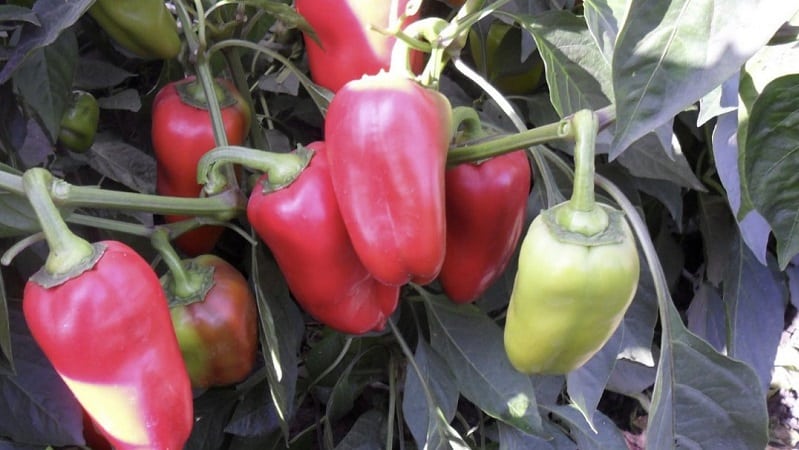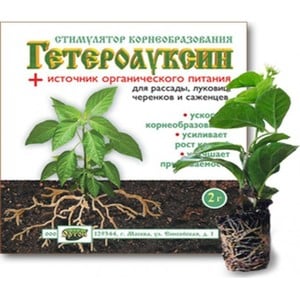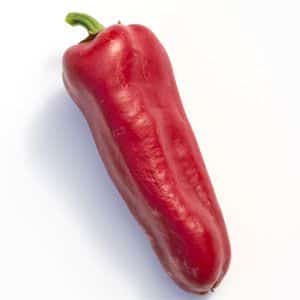High-yielding and early-ripening variety of pepper “Morozko” for greenhouses and open ground
Morozko pepper attracts gardeners with its unpretentiousness. The variety is resistant to frost and rain, and shows high yields year after year. The vegetable is consumed both fresh and after heat treatment. Pepper makes healthy vegetable salads, winter preparations and juicy side dishes.
100 g of pepper contains only 25 kcal, so the vegetable is excellent for the diet. Let's take a closer look at the characteristics and description of the Morozko variety and learn the secrets of a rich harvest.
What kind of variety is this
The vegetable is an early ripening vegetable; gardeners harvest in just 110-115 days. For care, you do not need to have special techniques and rules - Morozko pepper is not picky and produces a harvest even with minimal adherence to the rules of watering and fertilizing.

Distinctive features
Morozko differs from other varieties in its elongated shape and perfectly smooth surface. The variety is intended for cultivation in the West Siberian region. The vegetable is resistant to diseases and insect pests, and is perfectly stored and transported.
Fruit characteristics and yield
Cone-shaped fruits at the stage of technical ripeness acquire a green color, after which they become bright red. The weight of one vegetable is about 100 g, the wall thickness is about 0.7 mm. The taste is pleasant, sweet. From 1 sq. m, summer residents collect about 1.5-2 kg.
Interesting! Sweet peppers have the same effect on humans as chocolate. After eating a vegetable, the body produces the “happiness hormone” endorphin.
Preparation for cultivation
The beds for pepper are prepared in October, before the first snow. For vegetables, sunny and well-ventilated areas are allocated. Pepper prefers sandy loamy loose soil. The soil is carefully dug up and a mixture of humus and peat is added. Until spring, the soil will be saturated with useful compounds, becoming saturated and fertile.
With the arrival of spring, the soil is dug up again and large lumps are loosened. The beds should be free of debris and weeds. 2 weeks before planting, water the soil with liquid manure. Peppers are planted at a distance of 40 cm from each other.
In addition, seed preparation is required. Seeds are disinfected by soaking in a solution of succinic acid or in aloe juice. Seeds are placed in fabric bags and immersed in liquid for 24 hours. Afterwards they are taken out and laid out on a clean cloth to dry.
Important! Purchase seeds only from trusted places. Pay attention to the expiration date and integrity of the packaging.
Growing seedlings
High-quality seedlings require fertile soil and convenient containers. Seedlings are prepared in March, 3-4 weeks before planting the plant in the ground.
Planting pepper
 Peat tablets are recognized as an excellent way to grow seedlings. To do this, you will need a large plastic container and the tablets themselves. Place containers in a container and pour in a little water to make the tablets swell.
Peat tablets are recognized as an excellent way to grow seedlings. To do this, you will need a large plastic container and the tablets themselves. Place containers in a container and pour in a little water to make the tablets swell.
Place 1-2 seeds in each and sprinkle a small amount of soil on top. Next, a greenhouse effect is created by covering the container with film or thin glass. Seeds take a long time to germinate, about two weeks. In addition to peat tablets, gardeners use flower pots, wooden boxes, and plastic cups. The main thing is that the container is clean and dry.
The soil used is garden soil or purchased soil. In the first case, soil, peat, humus and sawdust are required in a ratio of 4:1:1:1. The composition is thoroughly mixed and poured with a solution of potassium permanganate for disinfection. Some gardeners advise disinfecting purchased soil to protect peppers from harmful bacteria and microbes.
Further care
The seedlings are placed on the windowsill, where there is a lot of light and warmth. The optimal humidity level for growing is 85-90%, temperature at least +18°C. After 2 weeks, the film is removed. Moisten the seedlings with warm, clean water; it is not recommended to use cold tap water.
 Water once every 4-6 days. To accelerate growth, stimulants are used, for example, Heterauxin.
Water once every 4-6 days. To accelerate growth, stimulants are used, for example, Heterauxin.
It strengthens the root system and increases the pepper's immunity to external influences.
“Heterauxin” is sold in any gardening store and comes in tablet form.
When grown in tablets, the seedlings are plucked after 15 days. Peat barrels are carefully pulled out of the container and, instead of peat, transplanted into a larger container.
The peppers are plucked carefully so as not to damage the fragile roots of the plant.
Important! Don't forget to fertilize the seedlings. Young bushes respond well to feeding Bordeaux mixture or ash. The drugs reduce the risk of developing the disease and accelerate plant growth. Fertilizers are applied once every 10-15 days, before watering.
Planting in open ground
A week before planting, the seedlings are hardened off: they are taken out to the balcony every day for 2-3 hours. Hardening allows the bushes to quickly adapt to the climatic conditions of the region. Before planting, it is recommended to lime the soil. To do this, the beds are sprinkled with a mixture of ash and lime.
The procedure lowers the acidity level and makes the soil more nutritious. Morozko is planted after the likelihood of spring frosts disappears. The seedlings are placed in pre-prepared holes, sprinkled with soil and the soil is carefully compacted near the base of the plants.
Pepper care
 The basis of care is regular watering of the plant. Moisten Morozko 2-3 times a week, about 1 liter of warm water is needed per bush. It is better to water the peppers early in the morning or in the evening to avoid sunburn. If the leaves of the bushes curl and turn yellow, it is probably not getting enough moisture. Once a week, instead of water, the peppers are watered with a yeast solution. The procedure improves the taste of the fruit and protects against pests.
The basis of care is regular watering of the plant. Moisten Morozko 2-3 times a week, about 1 liter of warm water is needed per bush. It is better to water the peppers early in the morning or in the evening to avoid sunburn. If the leaves of the bushes curl and turn yellow, it is probably not getting enough moisture. Once a week, instead of water, the peppers are watered with a yeast solution. The procedure improves the taste of the fruit and protects against pests.
Before each watering, the soil is loosened to make it lighter and more nutritious. Loosen the beds carefully so as not to touch the root system. In addition to loosening, gardeners regularly remove weeds. During the flowering period, pepper stems are sprinkled with loose, slightly damp soil.
An important stage of care is feeding the plants. Gardeners recommend alternating mineral and organic fertilizers. Peppers are fed 3-4 times per season. Fertilizers protect bushes from diseases and saturate them with vitamins and minerals. Morozko pepper responds well to feeding with ash, ammonium nitrate, liquid manure and urea.
Features of cultivation and possible difficulties
Some bushes break under the weight of heavy fruits, so they tie up to the support. This requires a wooden peg and a clean, dry cloth. The peg must be disinfected and installed near the bush. The plant is wrapped around the stem only once, and the knot itself is tied near the stakes.
When growing Morozko pepper in a greenhouse, gardeners ventilate the room daily. The greenhouse is characterized by high humidity, which can lead to the development of fungi and viruses. The greenhouse is ventilated using special vents.
Important! When the first ovaries appear, the beds are fertilized with potassium sulfate and superphosphate. When the fruits ripen, gardeners apply potash fertilizers.
Typical diseases and pests
 Insects appear on the beds during the flowering and fruiting periods. Peppers are attacked by Colorado potato beetles and their larvae. Pests overwinter in the soil and come to the surface with the arrival of summer. The bugs eat the leaves, which is why the fruits themselves soon die.
Insects appear on the beds during the flowering and fruiting periods. Peppers are attacked by Colorado potato beetles and their larvae. Pests overwinter in the soil and come to the surface with the arrival of summer. The bugs eat the leaves, which is why the fruits themselves soon die.
Experienced farmers advise fighting Colorado potato beetles with the help of professional preparations. An effective remedy is “Typhoon”. Often swarms of small white midges appear on the leaves. The whitefly appears in the beds unnoticed; it is impossible to see it with the naked eye. Whiteflies suck the juice out of the bushes, which disrupts the metabolism of the bushes and kills the pepper.
Occasionally, the Morozko variety suffers from black bacterial spot. Small brown spots appear on the stem and fruits, and their number increases every day. As a preventive measure, spraying with whey or aloe juice is used. If spotting does appear, it is recommended to immediately remove the bushes and burn them away from the beds.
Another worst enemy of pepper is late blight. A well-known fungus occurs due to heat and waterlogging. Brown spots appear on the fruits and leaves, the plant withers, and the peppers lose their elasticity. Bordeaux mixture, spraying with tar soap, saline solution, and the drug “Oxychom” help in the fight against late blight.
Harvesting and application
 Morozko peppers are harvested at the ripening stage, as soon as they gain red color. The ripeness of a pepper is determined by the crackling noise when you touch the fruit. The vegetable becomes firm but elastic. The first harvest is obtained in mid-August and harvested before the first frost.
Morozko peppers are harvested at the ripening stage, as soon as they gain red color. The ripeness of a pepper is determined by the crackling noise when you touch the fruit. The vegetable becomes firm but elastic. The first harvest is obtained in mid-August and harvested before the first frost.
If stored properly, sweet peppers will last up to 1 month. To do this, cut off the stalk, leaving a 1 cm tip. The fruits are wiped with a dry cloth and put in a dark, well-ventilated room.
Peppers make tasty and healthy dishes: stews, salads, soups and appetizers.
Morozko pepper is great for canning and pickling, and serves as an indispensable ingredient when preparing dietary foods. The sweetish taste of the vegetable adds piquancy and juiciness to dishes.
Advantages and disadvantages of the variety
Morozko pepper is loved for its ease of care. Even a novice gardener can grow a crop.
Morozko has other advantages:
- attractive appearance;
- high taste qualities;
- cold resistance;
- early ripeness;
- high and stable yield.
The vegetable has no significant drawbacks, but some gardeners note the short shelf life of pepper. Otherwise, Morozko is an ideal variety for both open ground and greenhouses.
Reviews
What do gardeners think about the Morozko variety? Judging by the reviews, the majority are satisfied with the harvest. However, there are also negative comments.
Maria, Tyumen: “I recommend the Morozko variety to everyone. The vegetable grows large, the fruits are smooth and even. It is very easy to care for, I spend a minimum of time on growing. The taste is sweet, the flesh is crispy."
Elena, Novosibirsk: “I always grow peppers in open beds.I tried to plant the Morozko variety, and was pleased. I made winter snacks and salads from vegetables, and they turned out very tasty.”
Pavel, Arkhangelsk: “I expected a rich and tasty harvest from Morozko pepper. However, the fruit set poorly, the maximum weight is only 70 g. Compared to other cold-resistant varieties, Morozko is very inferior. I don’t think I’ll plant it anymore.”
Conclusion
To obtain a rich harvest, gardeners recommend watering the beds in a timely manner and loosening the soil. Fertilize the soil with ash, a solution based on burdock, yeast and whey. Peppers are collected at the stage of technical ripeness, when they acquire a pale red color.
The variety rarely gets sick and is resistant to common pests. The vegetable is rich in vitamins and microelements; regular consumption of pepper improves the body's immunity and improves mood.